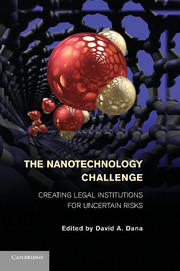Book contents
- Frontmatter
- Contents
- Contributors
- Part I Introduction
- 1 The Nanotechnology Challenge
- 2 Five Myths about Nanotechnology in the Current Public Policy Debate
- Part II Public Perceptions of Nanotechnology Risks
- Part III Meeting the Nanotechnology Challenge by Creating New Legal Institutions
- Part IV Where We Are Now – The Current Framework for Nanotechnology Regulation
- Index
- References
1 - The Nanotechnology Challenge
Published online by Cambridge University Press: 05 December 2011
- Frontmatter
- Contents
- Contributors
- Part I Introduction
- 1 The Nanotechnology Challenge
- 2 Five Myths about Nanotechnology in the Current Public Policy Debate
- Part II Public Perceptions of Nanotechnology Risks
- Part III Meeting the Nanotechnology Challenge by Creating New Legal Institutions
- Part IV Where We Are Now – The Current Framework for Nanotechnology Regulation
- Index
- References
Summary
Nanotechnology has moved quickly from the realm of theoretical science and science fiction to the stuff of everyday life for people across the world. Nanotechnology is deployed in hundreds of products and services and will soon be part of many thousands of products and services. Estimates vary, but nanotechnology is a multi-billion dollar enterprise worldwide now and could become a trillion dollar enterprise in the relatively near term. Everything from socks to tennis rackets to food to surgical techniques to state-of-the-art military technology now may include some form of nanotechnology. If petroleum and plastics formed the infrastructure of the chemical/industrial revolution that transformed countries such as the United States in the last 50 to 100 years, nanotechnology and nanotechnology products may well be the tiny – the nano – basis for the next gigantic revolution in how we live.
As Kimberly Gray explains in her contribution to this volume, nanoparticles – extremely tiny particles – have always existed and have been known to exist for a very long time. The nanotechnology revolution began when technologies were developed that allowed nanoparticles to be accurately imaged and manipulated to produce materials having surprising properties of value in a wide range of applications. Nanotechnology is not per se the realm of the very, very small, but of the engineered and manipulated very, very small. Indeed, the promise of nanotechnology is that atoms and molecules of common elements such as silver and carbon can be manipulated into so many shapes and with so many different surface modifications that they can perform a vast array of new functions.
- Type
- Chapter
- Information
- The Nanotechnology ChallengeCreating Legal Institutions for Uncertain Risks, pp. 3 - 10Publisher: Cambridge University PressPrint publication year: 2011



